




Karen Rose, OSB, Prioress
“Your way of acting should be different from the world’s way; the love of Christ must come before all else. You are not to act in anger or nurse a grudge. Rid your heart of all deceit. Never give a hollow greeting of peace or turn away when someone needs your love.”
Rule of Benedict, Chapter 4:20–26
Before you read the rest of this letter, take some time to meditate on the quote above from our founder, St. Benedict’s, Rule.
It was written in the sixth century C.E., and it’s been the foundation of monastic living ever since. Isn’t it amazing that something written so long ago is so relevant to life today? Wouldn’t it be a gift if people throughout the world would try to live what Benedict teaches?
Benedict’s teaching on loving, being kind and caring toward others weaves its way throughout the whole Rule. It forms the bedrock of how we are to live our lives, whatever the ministry to which we are called. Benedictines can be teachers, health care workers, pastoral ministers, artists, writers, homemakers, lawyers, accountants, or serve in hundreds of other ways. The Rule doesn’t specify what our work and ministry has to be to make us Benedictines, but it clearly asks that we approach every labor we are assigned with an open, loving heart.
In this issue, we are focusing on
some of the ways throughout the years that our sisters (and friends) have tried in very specific ways to make a loving approach to living visible in the world. We have been thrilled to welcome our social justice ministries director, Elizabeth Reum, to help us with this work and want to thank you for your generous donations which make this possible.
May St. Benedict pray that we can continue to partner with our likeminded friends so that we never “turn away when someone needs [our] love.”
In peace and love,
 Karen Rose, OSB Prioress
Karen Rose, OSB Prioress

Benedictine Sisters and Friends
Number 28 –Spring 2024
Karen Rose, OSB Prioress, Consultant Editor
Amanda Hackett Editor, Graphic Designer
Renée Domeier, OSB Proofreader
On the Cover: Saint Benedict’s Monastery, taken by Amanda Hackett
Photos: Carleen Schomer, OSB, Karen Streveler, OSB, Marina Schlangen, OSB, Nancy Bauer, OSB, unless otherwise noted or supplied by individual sisters or Saint Benedict’s Monastery Archives
Printing: Palmer Printing
Benedictine Sisters and Friends is published annually by the Sisters of the Order of Saint Benedict, St. Joseph, Minn. The purpose of this magazine is to share the stories of our Benedictine lives and engage our relatives, friends, oblates and benefactors in the mission and ministries of the Sisters of the Order of Saint Benedict.

Over the years, Saint Benedict’s Monastery has been committed to living out principles of social justice and connecting the community to one another as children of Christ. Enjoy reading about some of our recent efforts.
Our social justice ministries team finds immense joy in providing opportunities for all to experience meaningful traditions, such as meeting Santa Claus at Christmastime. This December, we held a Santa and Mrs. Claus meet-and-greet at Centered on Christ Catholic Community in Rockville, Minn. Families were invited to meet Santa and Mrs. Claus, played by monastery friends Luciano and Paola, and pick out Christmas gifts for their loved ones. Nearly 100 people, including many Spanish-speaking families, came through, and this was the first time any of the children had ever seen Santa—they were all so excited! After sitting on Santa’s lap and receiving a gift, the children and their parents were able to pick out gifts for their families and wrap them at a wrapping station. Many shared that their children would not have received any gifts if it weren’t for this event, and we’re grateful to have supplied some Christmas cheer.

“Never ... turn away when someone needs your love.”
Rule of St. Benedict, Chapter 4:25–26

This winter, our social justice ministries team held a donation event that served over 200 people. We shared over 300 pounds of beans, rice and lentils, canned goods, 30 boxes of diapers, over 100 blankets, toothbrushes/toothpaste, pillows, towels/washcloths, children’s toys, over 100 winter coats, and hundreds of items of clothing, boots and shoes. There were two tables full of dishes, pots and pans, cutlery, cups, glasses and other household items, and our guests were also able to take couches, bed frames, mattresses, dressers and end tables. All the donations we receive come through word of mouth. Elizabeth Reum, director of social justice ministries, shares that she gets calls every day from people who hear about us from their neighbor, cousin, coworker, friend, etc., and would like to help. We are abundantly blessed with a community that cares!
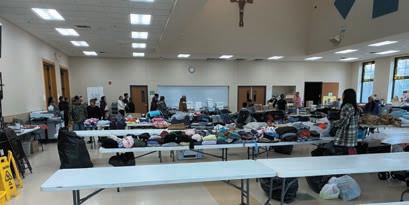
Dorothy Manuel (in green) with students
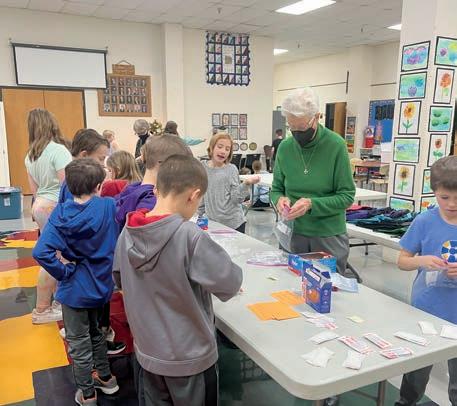
Sisters teamed up with students from St. Joseph Catholic School in St. Joseph, Minn., to assemble “essential bags” to share with people who are homeless or struggling. Essentials included combs, Kleenex, deodorant, soap, body lotion, washcloths, Chapstick, shampoo, conditioner, toilet paper, toothbrushes, toothpaste, floss, Band-Aids, first aid kits, snacks, and COVID-19 tests. The bags were shared with the St. Joseph Community Food Shelf and The Homeless Helping Homeless Lincoln Center.
For Easter, Faith Feeds, a local nonprofit organization that supplies meals for those in need during the holidays, shared 300 meals that our social justice ministries team delivered to families so they could enjoy a lovely Easter meal. In addition to delivery, the sisters were happy to play a part in food preparations by scrubbing, peeling and baking the potatoes.
Left to right: Sisters Michaela Hedican, Hélène Mercier, Director of Social Justice Ministries Elizabeth Reum, Sisters Karen Rose, Christian Morris and Lucy Miller

“My name is Elizabeth Reum, and since the end of October 2023, I have been the director of social justice ministries for Saint Benedict’s Monastery. The past few months have been a fun and exciting journey for me, and I cannot wait to share it with others. I have been a clinical social worker in the area for the past 30 years and have seen the need in our communities—not only financial need, but the need to feel as though life has meaning.
When I was younger, I would ask myself, ‘What is your purpose?’ It took time for me to articulate the answer: ‘I am a gardener.’
We who want a better world are all gardeners. We plant seeds, and sometimes they thrive and grow right away, but other times it may take a bit more patience. I am a believer that people inherently want to help others but may not know how or are overwhelmed by life and are looking for a direction. When like-minded people come together, we can truly cause more than a few ripples in the pond.
I am looking forward to sharing ideas of how we can work together to help others, heal rifts in our communities, and bring people together.”
 Meet Elizabeth Reum
Sister
Meet Elizabeth Reum
Sister
Group leaving for the Greenwood mission
Benedictines traditionally have no specific ministry to which they are tied or obliged, but over the centuries, they have ministered widely—locally, nationally and globally. The fields of education and health care were priorities for the Benedictine sisters in St. Joseph, Minn. While not usually labeled as social justice, they fall under that heading.
The original impetus to ministry came from the Gospel and the Rule of St. Benedict, both impelling followers to serve needs of the Church and society, seeing all people as children of God. A later impetus for expanded ministries came from Vatican II directives. However, prior to Vatican II, Benedictine sisters were already engaged in a variety of social justice causes.
Our community encountered the problem of segregation head on during the late 1930s.
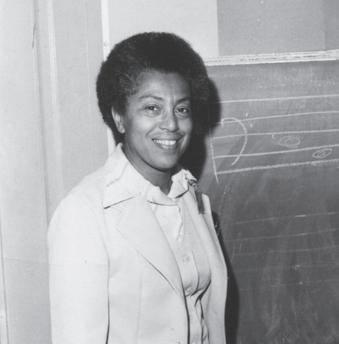
Segregation of Black and white Americans was United States law from the 1890s on. Sadly, even Catholic institutions observed this law, whether private or public. However, in 1938, two Black women applied for admission to the College of Saint Benedict in St. Joseph and were accepted by the dean, Sister Claire Lynch. Some alums protested, but S. Claire responded firmly that the college would adhere to Christian principles, condemning racial discrimination as immoral and unjust. During the 1940s and ‘50s, the college accepted several more
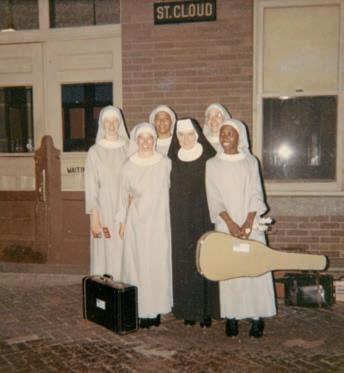
Black students—no objections—and our community received into membership Joyce Williams from Mississippi, the first Black Benedictine in our history, in 1948. Segregation was under attack by the late 1950s, and in the early 1960s, it was dismantling nationwide, but the resistance was still fierce, so the sisters decided to take a more active part in helping Black citizens claim their rights. In the summers of 1965 and 1966, sisters from our monastery worked at St. Francis Center in Greenwood, Miss., a place established to aid poor, mainly Black, people. Aid was offered in the form of clothing, medicine, donated books and classes to improve reading skills. Letters from the sisters kept the community informed of daily activities and urged a growing consciousness of racism and extreme poverty in a nation boastful of its prosperity.
The motherhouse gave strong support to the Greenwood mission. Five sisters spent several weeks there each summer, most of them teachers by profession. It proved to be an eye-opening experience for them and the community as a whole.
After 1965, Vatican II fostered an outpouring of new or expanded ministries. A lesser-known ministry was located in northern Minnesota, near the town of Kent. This section had large beet fields, and hundreds of migrant workers gathered there each summer to hoe these fields. The families were

poor, lacking many basics of life such as education, medicine and good housing.
Beginning in 1967, our sisters volunteered to aid these migrant workers. Usually, this entailed living in Kent and going out to the workers’ shacks and bringing them necessities, as well as holding classes for the children. Our Sister Lorraine Klein, among the first to volunteer, spent several weeks each summer for several years in this ministry. Her letters to community, relatives and friends described the sisters’ activities and how grateful the workers were for this aid. The number of sisters fluctuated, but the norm seems to have been two to five each summer. By the mid-1970s, the number of migrant workers dropped considerably as the beet fields declined in size and number; the sisters’ services ended at that point.

refugees, nuclear weapons, racism and welfare reform.
Benedictines for Peace, organized in fall 1981 in Erie, Pa., led to national and regional groups, such as Pax Christi, advocating on behalf of peace and respect for all life. At a September chapter meeting in 1986, our community voted to endorse the Sanctuary Movement for refugees from Central America, with emphasis on Guatemalans and El Salvadorans, who needed protection from persecution in their homelands. We offered shelter and supplies for refugees and wrote letters of appeal to the president, Congress, bishops and others, seeking federal and state aid on the refugees’ behalf.
Commitment to social justice soared during the 1970s and ‘80s. In 1975, the monastery’s Global Awareness Task Team was founded, the initiative taken by Sister Merle Nolde and assisted by several other sister volunteers. It linked often with another task team which formed at the same time, Apostolic Concerns, headed by Sister Firmin Escher. Both teams proposed to examine and prioritize community concerns and ministries, though the Apostolic Concerns Task Team was more focused on traditional, local ministries and how best to expand or consolidate them. Community members were heavily invested in education and health care, and the Global Awareness Task Team aimed to broaden perspectives. They helped educate the community to become aware of Central American
Social justice action has increased in scope and intensity these past three decades as our community continues involvement in various social justice causes, taking on new ones as needs arise. As of 2024, the community even has a director of social justice ministries, Elizabeth Reum, to coordinate our efforts. You can learn more about our social justice efforts, past, present and future, throughout the pages of this magazine.

In October 2021, Pope Francis invited the entire Church to participate in a Synod on Synodality. Drawing from the New Testament and the life of the early Church, the Second Vatican Council of the 1960s called for a return to a church that engages every member of the Christian community. Pope Francis calls for a renewal of this way of being church. At the beginning of the three-year Synod, local dioceses throughout the world were active in gathering people to “listening sessions” to talk about their experience of Church.

A general review of the Synod’s work, its intention, and the processes it followed bears striking resemblances to Benedictine monastic life. Growing in the “full stature of Christ” is the goal both of the Synod and of Benedictine life. Both ask the question: “How is the Spirit inviting us to bring the message and mission of Christ to the world in the third millennium?” A Spirit-filled response to the question, whether in the monastery or in the
synodal church, relies on every member’s vision and voice.
Invited members of the Synod gathered in Rome to hear and collect what came from churches throughout the world. Traditionally, a papal synod is an assembly of bishops representing the Church to give counsel to the Pope in the governing of the universal church. The current Synod looks very different from past synods, in which bishops (the sole participants) gathered in a theatre-style hall to advise the Pope about concerns in the universal church. At this synod, participants sat in small groups at round tables that included a mix of lay people, deacons, those in consecrated life, priests and bishops. The process demanded deep listening to understand and accept the broad diversity of persons and perspectives in the Church. Listening led to dialogue, communal discernment and consensus building. Pope Francis has long emphasized the importance of “mission” for the Church of the future. The Synod on Synodality clearly demonstrated that mission rests, in the first place, with the priesthood of the baptized.
Benedict’s synodal pattern of life originates from the baptismal call that unites the members of the Body of Christ. The emblematic “Listen” at the beginning of the Rule of Benedict strikes a tone very much like that of the Synod. The monastic community, a micro-church, is made up of “a variety of characters,” all of whom bring individual voices, diverse gifts and different habits of being.
The promise to listen is the promise to obey. “Journeying together” depends on everyone’s engagement in the common life. In its structure, the practices of daily living, and the exercise of obedience and authority, the monastery is synodal. Benedict does not regard status or title of singular
importance. The structure of the life is organic rather than bureaucratic. In the manner of the early Church, the exercise of authority grows from the gifts of the community members. The work of the synod affirms this understanding of authority. It is a gift that rises from within the community rather than something imposed from the outside. In the monastery, the prioress or abbot “is believed to hold the place of Christ” (RB 2:2) and is first to receive our obedience. Her authority rests, in part, with the community, who has called her to this task. Her obedience, like all the members, lies in “listening with the ear of her heart” (RB Prologue 1) to what is the mind of the community.
When there are important decisions to be made, she calls the whole community for counsel. The voices of the young, the observations of visitors, the wisdom of the elders, and the treatment of one another are the actions of a “synodal monastery.” As one body, the community discerns the Spirit’s call into an unknown future in the same manner of the current synod. Through deep listening, dialogue, communal prayer and consensus building, Christ is realized in his Body and all its members.
In his opening address of the Synod, Pope Francis said, “We are here to walk together with the gaze of Jesus, who blesses the Father and welcomes those who are weary and oppressed. So let us start from the gaze of Jesus, which is a blessing and welcoming gaze.”
As we move into the third millennium, Pope Francis believes that the Holy Spirit is calling for a synodal church that is dynamic, engaging and alive in Christ. Insofar as monastic life grows in inclusivity, hospitality and acceptance of diversity, it can model the synodal church with dynamism and engagement.

“… let us start from the gaze of Jesus.”

Benedictines for Justice, Peace and Integrity of Creation (BJPIC) is a monastery task team comprised of sisters and laypeople. This team meets monthly to discuss various social justice issues. Below are some thoughts from two members of the team about why they are involved.
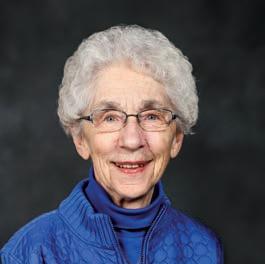
“The answer to who/what influenced my passion for social justice is long and varied: The scriptures’ concern for the ‘widow, the orphan and the alien/ refugee’; the World Synod of Catholic Bishops declaring in 1971: ‘Action on behalf of justice and participation in the transformation of the world fully appear to us as a constitutive dimension of the preaching of the Gospel’; my mentor, Sister Merle Nolde; trips to El Salvador, Mexico, China and Perú; my LGBTQI2S+ friends.
A trip to Cuernavaca, Mexico, in 1996 with Sister Mary Catherine Holicky and College of Saint Benedict students deeply touched me. We attended a meeting of the local farmers with the city government. The government wanted to buy out the farmers so they could build a huge golf course for United States vacationers and hire out the farmers. I’ll never forget the farmer who pleaded with the government: ‘We need our farms to feed and raise our family; green grass and golf do not raise a family.’ The farmers lost. God of justice, transform us!”
Mary Beth La Valley, OblSB

“I was matched with the BJPIC Task Team after expressing interest in these themes on an annual survey for oblates because I believed I might have some practical experience to offer. My interests in peace, social justice and ecology were inspired by the example of my mom and dad. I was raised in a socially active Christian Family Movement family through the Civil Rights protests, the Vietnam War, the Nixon years/Watergate, and the Equal Rights Amendment effort.
At the College of Saint Benedict, I studied honors, government and constitutional law. I also spent a semester in Washington, D.C., as Representative James Oberstar’s First Congressional Intern. During subsequent work with several representatives in Congress, I developed an understanding of how legislation is crafted, negotiated and how we, as constituents, can have a voice in forming legislation. Throughout the years, I have been a consistent voice for conservation, equity and inclusion. It is my firm belief that if we work together, we have the ability to make a difference in the world we live in.”

Baskets, a powerful symbol throughout the Scriptures, symbolize the varying social, economic and emotional needs of our brothers and sisters around the world. Some baskets are overflowing with blessings, while others remain empty. As Benedictines, we listen and respond to the needs of others, and there are empty baskets of needs everywhere which we seek to fill.
Using the symbolism of baskets as our guide, our 2023 Give to the Max campaign raised funds to support our social justice ministries. With immense gratitude, we thank all who contributed $84,020 to this campaign. Because of your partnership and generosity, we are together able to share our baskets of blessings with those who need our love. Contributions are being used to assist those who have urgent or immediate needs, engage in environmental projects and other social justice initiatives, and educate and collaborate with local schools and organizations.


Baskets
In the basket of our hands we carry the bounty of creation to the world’s table where many hungers wait for the work of interwoven hands— humble holy human.
Written by Mara Faulkner, OSB
For the second consecutive year, Saint Benedict’s Monastery celebrated Catholic Sisters Week, March 8–14, by partnering with the Central Minnesota Catholic Worker to raise funds for Laundry Love, a national organization that helps low-income families afford laundry services at partnering laundromats. The Central Minnesota Catholic Worker has served as a Laundry Love partner in St. Joseph, Minn., since October 2022.
Laundry Love is held at the St. Joseph Laundromat the first and third Tuesday nights of the month from 5–8 p.m. During that time, individuals and families can use quarters and available laundry supplies to do their laundry. Five to 10 individuals or families generally participate each time, and Laundry Love aims to have $200 available each session.
This year’s effort raised $1,481.43 for local families in need. This total amount supports seven sessions of Laundry Love—nearly four months! Thank you to all, near and far, who supported this effort to give people dignity through clean clothing.
If you’re interested in volunteering with Laundry Love, please contact the Central Minnesota Catholic Worker at centralmncw@gmail.com.
“If I had clean clothes, people would treat me like a human being.” T-Bone (Eric), Laundry Love Co-Founder

Icouldn’t give it away. When I sat down at my sewing machine to make sure it still worked, it felt so good, so right. I couldn’t part with my friend and companion of so many years. But how to sew without the painstakingly arduous process of sewing for myself with all the needed pattern alterations?
Internet to the rescue! Online I found Little Dresses for Africa. This nonprofit ships simple dresses
made by women across the United States to girls in various countries within Africa. Inspired and excited, I downloaded a simple pattern from a website, Nancy’s Notions. Entering a fabric store to purchase the first yardage was like coming home.
In order to be faithful to my new sewing project, I asked the parishioners who attended my weekly 7 a.m. Holy Eucharist to hold me accountable. I would make a dress a week, or at least close to that.


Once 25 dresses were finished, I brought them to the Eucharist. Sharon and I would set them up in the altar area, attendees would come up to the altar where we would do a liturgy of blessing, and then I would lovingly pack up and send the dresses to Michigan for shipment to Africa.
This momentum, begun in 2017, was interrupted in 2020. During the COVID-19 pandemic, I set the dressmaking aside and made scores and scores of face masks, mostly using the scraps from the dresses that I had made. Then in 2021, I ended my work at the Episcopal church where I was serving and no longer had the group to hold me accountable. The sewing that brought so much joy slowed to a crawl, and life interfered with the joy of making those dresses.
To return to this ministry, in Lent I decided that dressmaking would be one of my Lenten practices. My goal was to make a dress a week or at least every week and a half. I would be delighted to say that I was successful. The truth is, I made two dresses—a disappointment to me. With this


“failure” to meet my Lenten promise, I was once again reminded that I cannot do it all. Sigh. Tough when one really wants to do it all and enjoys doing it all (well, mostly all).
When we add a new task to an already busy life, something has to give. That means undermining either the new task or what we are already doing. I had a full schedule to which dresses were re-added. Perhaps my expectations of myself were not realistic. Another sigh.
However, all is not lost! My missing the mark in fulfilling the Lenten practice of dressmaking for the girls has helped me realize that our promises in Lent need not stop at Easter. Perhaps my dressmaking in Lent was a warm-up to get fully back to what I love to do. I am endeavoring to spend even a little time each day sewing. It’s hard given other responsibilities, but I want to serve Christ through this ministry of clothing the girls (Matthew 25:36). My prayer is to be faithful to the girls and to what brings me joy.
Jane Tomaine is an Episcopal priest, author and retreat leader. She leads workshops and retreats on the Rule of Benedict and Benedictine spirituality for churches, organizations, monasteries and retreat centers. Visit Jane’s website at www.stbenedictstoolbox.org.
Learn more about Little Dresses for Africa at www.littledressesforafrica.org/.
If you’re interested in sewing your own Little Dresses for Africa, you can use this template from Nancy’s Notions at www.nancysnotions.com/make-a-dress-for-little-dresses-for-africa/.
“The Earth is Full of God’s Riches”
Celebrating the nature photography of Sisters Carleen Schomer, Karen Streveler, Linda Dusek and Nancy Bauer
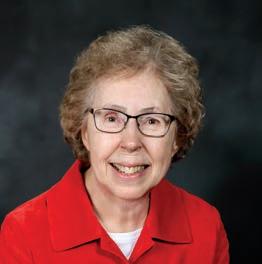
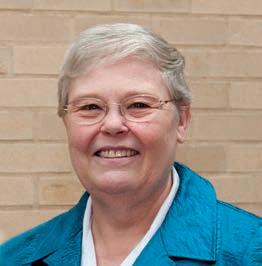

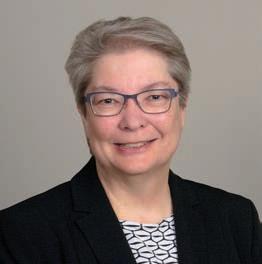
The 2024 Haehn Museum exhibit opened to the public on April 4, 2024. This year, we are featuring the works of four of our nature photographers.
For many years, the beauty of the earth has motivated our sister photographers to use hours of patience and skill to capture the glory of God’s creation bursting gloriously all around us. The major message of Pope Francis’ Laudato Si’ also motivates the pictorial message of our artists, and quotes from that work and psalms accompany the photographs in the exhibit. It is arranged as a self-tour, so come and linger with us.
After touring the museum, guests are invited to visit Whitby Gift Shop, where many items handmade by sisters and other artisans are available for purchase. Come marvel over the splendor of God’s riches!

“Photography is essentially a means of visual communication capturing a moment and holding it in a way that is unique.”
Tuesday–Friday: 12–4 p.m.
Saturday: 10 a.m. to 3:30 p.m.
Closed Sunday and Monday
There is no charge to visit the exhibit, and special arrangements can be made for groups and for tours outside business hours. Contact Sister Judy Kramer, museum director, at (320) 363-1605 or j1kramer@csbsju.edu.
Benedictine Sisters and Friends
Judy Kramer, OSB Carleen Schomer, OSB Karen Streveler, OSB Linda Dusek, OSB


“Each creature reflects something of God.”
Laudato Si’
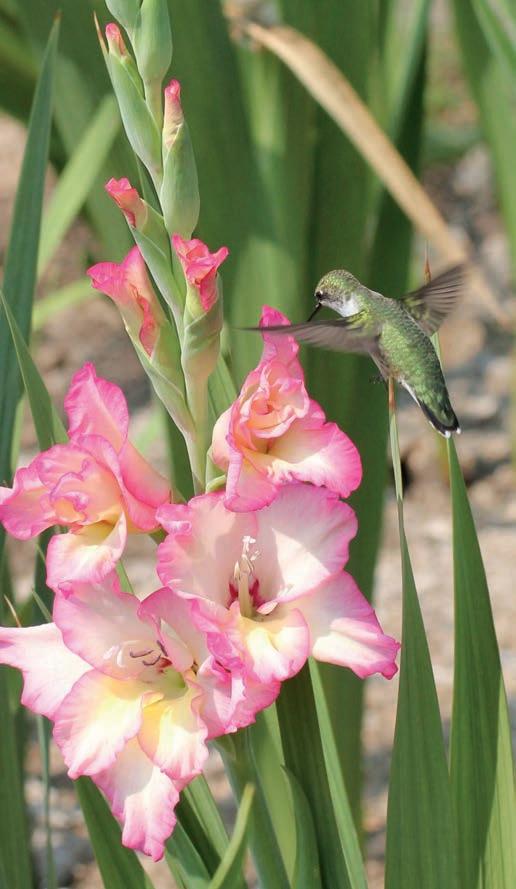

 Linda Dusek, OSB
Carleen Schomer, OSB
Nancy Bauer, OSB
Karen Streveler, OSB
Carleen Schomer, OSB
Karen Streveler, OSB
Linda Dusek, OSB
Carleen Schomer, OSB
Nancy Bauer, OSB
Karen Streveler, OSB
Carleen Schomer, OSB
Karen Streveler, OSB
Blessed to be an educator for 44 years, one considers from time to time the impact on those lives touched. My work with children, from birth to high school, encompassed many facets of serving children; however, nearest and dearest to my heart is the gift of literacy.
I learned from this literacy work the economic and social factors that affected the literacy development of these children, and that literacy is not only about their ability to read but includes their language development of speaking, listening and vocabulary.
One theoretical consideration I questioned throughout my career in education was:
“Why in a country where we are blessed to live, with its resources and riches, do we lag behind other industrial countries in the percentage of children who can read at grade level?”
It was this question that led me to surprising data pointing to social and economic factors affecting our children. A study by Steven Zauderer estimates 54% of adults read below the sixth-grade level. He goes on to suggest these “low literacy rates cost $2.2 trillion a year” and “two-thirds of students who cannot read proficiently by the end of fourth grade will end up in jail or on welfare.”1
My work on behalf of children began early in my career. I worked as a teacher of the deaf/hard-ofhearing and as a speech/language therapist with the birth-to-five children. This included home visits with children birth to three.
It was an eye-opening experience for me. Each and every home I visited had its own unique
Mary S. Baier, OblSBenvironment, and I fully began to understand how, in some homes, poverty was a limiting factor in a child’s life. The difference was often the lack of resources including children’s books and toys appropriate for their development.
In the 1990s, a wealth of research became available regarding the brain development of children birth to five. Overwhelmingly, the research pointed to the importance of these children being in rich and stimulating environments to foster language development and literacy. It suggested that children living in poverty had a word gap of 30 million words when entering kindergarten compared to children from a higher social economic background.2 One of the important findings of this research was the critical need for parents to read to their children beginning when they were only a few days old.
In 1997, the “Books for Babies” program was initiated in the Red Wing, Minn., community thanks to a grant I wrote and received from the Minnesota Department of Education. The partners in this project included a wide berth of community services who worked with this age group. It became an extensive collaborative that focused on language and literacy development for children birth to five. There were many outcomes from the community network developed, and the greatest result was that every new mom and baby leaving the Red Wing Hospital was given a book called Read to Your Bunny by Margaret Wise. The packet given to new moms not only included the book for baby but also important listings of resources for them to access. The nurses were trained to talk with the moms about the importance of reading and talking to their baby when they went home.
Last time I checked several years ago, this is still happening.
My work to close the achievement gap for children in poverty extended to other Minnesota communities including Rochester and Owatonna, as well as Plum City, Wis. Working with teachers, we were able to make a concerted effort to identify children in kindergarten to third grade who needed additional help with small group reading interventions.
Finally, I have come full circle. In 2023, I asked for corporate gifts to begin the “Read to Me” project for three-year-olds attending Reach-Up Head Start, a local nonprofit that provides free programming to prepare children for success in kindergarten and offers support to parents. The project allows volunteers to read a book to the children, and then each child is given the book to take home and read with their parents. I was the volunteer reader in March and was thrilled to be back in the classroom with these youngsters. These little ones feed my soul.
It is often said:
“There’s a ripple effect in life. We can toss a single stone in our lives that will radiate ripples outward in all directions. One small toss can affect our lives, and that will continue to ripple sometimes for a lifetime.”
I can only hope a large stone was thrown and the ripples will continue to make a difference for the children and their love of reading. This work to bring literacy development to children could not have been accomplished without the many others who collaborated and understood the value of closing the achievement gap for children in poverty. It was a blessing to work with these partners and serve the children.
1 Steven Zauderer. June 30, 2023. www.crossrivertherapy.com
2 Hart & Ridley. February 5, 2020. www.purdue.edu
Mary (back) with students at Reach-Up Head Start; photograph provided by Reach-Up Head Start

Sister Dolores Super became my organ teacher in January 2020, and my life was forever changed.
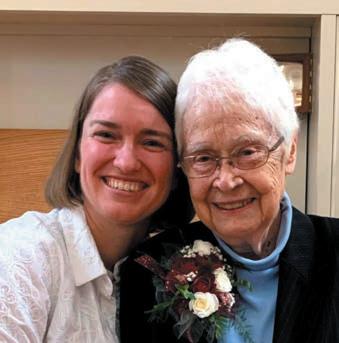
I moved to Minnesota in fall 2019 to study at Saint John’s School of Theology and Seminary in Collegeville, Minn. I arrived with a degree in organ performance but wanted to continue studying organ, and I needed someone who would challenge me. Fortunately, S. Dolores agreed. People often say, “Be careful what you wish for.” This was definitely true with S. Dolores. She challenged me in ways I could not have imagined, mentoring me to advance three or four levels.
For my first lesson, I played just one solitary note—a G in Johann Sebastian Bach’s Fugue in G Minor. She immediately interrupted and said, “OK. I’m going to stop you right there. You need to play that note with more authority. You need to get our attention and make us want to listen to you.” At that moment, I knew I had the perfect teacher and that our paths had crossed at exactly the right time. S. Dolores was almost 90 years old, and she had stopped teaching years earlier but still had so much to give. My hope was to soak up everything I could.
At the second lesson, I made sure to play the first note with authority. To my dismay, she stopped me after the second note claiming she had not heard four 16th notes in the quarter note I played. She said, “The whole piece hinges on the first notes.”

Much of what I learn in lessons with S. Dolores, I apply to life. Playing or living with more authority is only one of them. She stressed that every note matters. How true this is in life where every person and all of creation matter!
Learning notes and rhythms may seem the final step for some, but not for S. Dolores. For music to “happen,” they are only the first step. Music has to move, to go somewhere. It may tell a story or paint a picture. S. Dolores would say, “It is not just note, note, note.” My hunch is that if I do not play musically, S. Dolores will haunt me.
Breathing is key to good organ playing. S. Dolores describes accompanying the Liturgy of the Hours as providing a “soft pillow” as the foundation. Together, the organ and singers breathe and praise God as one voice. This way of playing elevates and enhances sung liturgical prayer.
I am forever grateful for the music and life lessons I learned from S. Dolores. Often, at the end of a lesson, I would comment that she wore me out. She would reply, “You should be worn out. That’s how you know it’s a good lesson.”
Our lessons not only wore me out—they changed my life. My strong desire to continue taking lessons led me to stay at Saint Benedict’s Monastery for one-and-a-half years during the COVID-19 pandemic. I fell in love with the sisters and their way of life and transferred my promise of stability, becoming an official member of the community on December 8, 2023.
My life has been forever changed. And to think, it all started with one little note that needed to be played with more authority.
Amanda Hackett
The Spirituality Center•Studium, a ministry of Saint Benedict’s Monastery, St. Joseph, Minn., responds to the human longing for God and invites others to join the monastic community in deepening relationships with God, self, others, and all creation.
To fulfill the Spirituality Center•Studium’s mission, their team strives to offer programs, retreats and other opportunities that invite guests to open their hearts and minds to each other and the world around us. This includes offering a space to learn about and discuss topics that span peace, social justice and the integrity of creation. Past programs have included:
» Book studies on racism

» Educational sessions about published works written by Pope Francis, including Laudato Si’, the encyclical that urges us to “care for our common home”
» Classes that educate us about antisemitism and explore how we can play a role in combating it
» Interfaith sessions called “My Neighbor is Muslim”
» International potlucks
» Discussions about books that explore ecological issues, including Ask the Beasts: Darwin and the God of Love by Elizabeth Johnson and A New Climate for Christology by Sallie McFague
» A half-day conference that observed the 500th anniversary of the Reformation
» Many classes that explore how we can be peacemakers and pursue peace in a troubled world, including writing workshops and discussions
» Rainbow Support Evenings that invite GLBTQI+ persons and their parents, allies and friends to gather and pray, share stories, and support each other.

To explore upcoming programs at the Spirituality Center•Studium, visit www.sbm.osb.org/ministry/ spirituality-center-studium/.
In addition to being a writer in my day job, I also write biographies of Roman Catholic sisters for Wikipedia, and I help sisters publish their own books and articles. I found Benedictine Sister Arleen McCarty Hynes on a list created by Women in Red (WIR), founded by prominent Wikipedia editors. WIR’s goal is to “turn red links blue.” “Red” means a woman should have a biography but doesn’t, and it turns “blue” when the biography goes up. I happily published 15 sisters’ biographies from that list without a problem. However, a minor fuss ensued with the page for Arleen McCarty Hynes, a Benedictine sister of Saint Benedict’s Monastery in St. Joseph, Minn.
Arleen McCarty married her beloved husband, Emerson Hynes, in 1939 when he was a professor at Saint John’s University, Collegeville, Minn. She worked in the library at the College of Saint Benedict, St. Joseph, during the 1940s and 50s. They had 10 children and a lively home called Kilfenora where they hosted Catholic artists, writers and intellectuals. Guests included journalist and activist Dorothy Day, sculptor Don Humphrey, Catholic novelist J. F. Powers, and many from the religious
Carole Sargent, Ph.D.community surrounding Saint John’s. In 1959, they moved to Washington, D.C., so Emerson could work for his old college roommate, Democratic Senator Eugene McCarthy (not to be confused with Republican Joseph McCarthy of the 1950s Communism hearings).
In Washington, D.C., Arleen worked as a librarian at St. Elizabeth’s Hospital. She and Emerson were happy for 11 years, but in 1971, a son drowned, and six months later, Emerson died of a heart attack, leaving Arleen a 55-year-old widow with eight children. After her retirement, she returned to the Collegeville area and entered the Sisters of the Order of Saint Benedict. For the last 20 years of her life, she worked in the monastery’s Spirituality Center, at a battered women’s shelter, and with inmates and seniors. She is buried in the monastery cemetery.

S. Arleen was one of the earliest pioneers of bibliotherapy, a technique of reading with mental health patients and interpreting literature and poetry that she developed in her years at St. Elizabeth’s. She founded the Bibliotherapy Roundtable and became internationally known for writing and speaking. She contributed articles to the academic Journal of Poetry Therapy, and she and her daughter, Mary Hynes-Berry, cowrote Biblio/Poetry Therapy: The Interactive Process: A Handbook,
published by the North Star Press of St. Cloud in St. Cloud, Minn., which became a classic.
So, what happened with Wikipedia? Well, although many think just anyone can write for it, and that’s technically true, posting work that stays up is challenging. Every fact must be footnoted from a third-party source such as a published book or article. Automated bots patrol for unsourced facts, speculation, misinformation and even vandalism, and they usually arrive first on the scene to approve the article. In addition, tens of thousands of volunteer editors also monitor pages within their interest areas. Within just one to two hours of posting any Catholic sister’s page, I am usually checked out by people from categories of Women in Religion, Catholicism, Biography, and Women in History, plus others who may have regional interests in the state or in the ethnicity of the subject.
After posting the biography of S. Arleen McCarty Hynes, imagine my shock when a male editor on Wikipedia nominated the article for deletion, claiming she wasn’t prominent enough. I didn’t immediately argue back because online squabbles are public record and can put you in the editorial doghouse. Instead, I made a powerful friend by reaching out to a top member of Women in Red. She came to my electronic rescue, explaining to him that S. Arleen was indeed prominent enough. Then, other WIR editors chimed in, defending S. Arleen. Within 24 hours of the deletion nomination, the process worked well, and her page was approved by robust consensus.
A WIR editor consoled me that pushback happens often when we write women’s biographies. Because editors can’t just “look her up” (although, ahem, she was easily searchable online), they can
mistakenly conclude she wasn’t prominent without considering that women so often get unfairly written out of history. But as Dr. Nicholas Mazza, editor-in-chief of The Journal of Poetry Therapy and her dear colleague, assured me, she absolutely belongs on Wikipedia, and there she will remain. He gave me some great citations to add to her page, and I hope readers who knew her will fact-check it and send me thoughts.
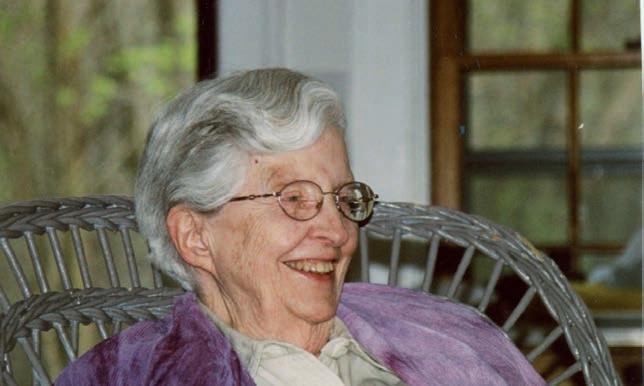

Carole Sargent is the founding director of the Office of Scholarly Publications at Georgetown University in Washington, D.C., where she guides faculty researchers to book and article publication. Through this work, as well as her involvement as an associate of the Sacred Heart, she developed a personal vocation of telling the stories of women religious and making their contributions known to the world.

Sister Jeanne Marie Lust has been a club champion at Rich Spring Golf Club in Cold Spring, Minn., 13 times.


Sister Lisa Rose has gone skydiving. Sister Margaret
has planted over 400 trees and monitors 24 birdhouses.


We established Benedictine communities in the Bahamas, Puerto Rico, Japan and Taiwan.
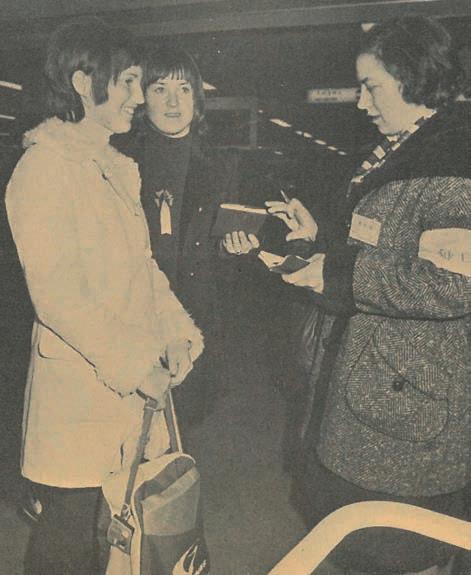
Jane
was a translator of Japanese, German and English for the 1972 Winter Olympics.


instruments.

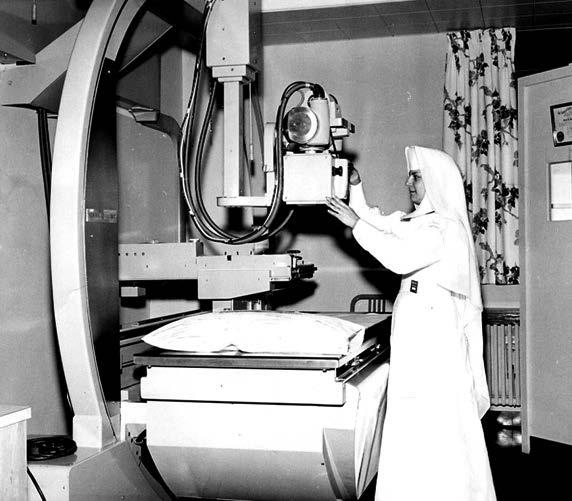
We established three hospitals, two schools of nursing, one school of X-ray technology, and one school of anesthesia.
ass on the baton” refers not only to a new conductor or parade majorette—it’s a term often used to indicate a major passage of life. Facing retirement, a person may declare: “It’s time someone else takes over.” Then there’s another saying heard with some dismay: “A woman’s job is never finished.” That’s usually indicating that domestic work goes on and retirement doesn’t ease it much.
While aspects of a sister’s work may, in time, be transferred to a younger professional, still her commitment to others remains. Teaching and health care employment may cease to occupy her days, yet valued contributions of time and service continue. One can hardly imagine life without giving to some extent. The value of ministry is the blessing it continues to provide even as one ages, so work remains a core part of a sister’s day.
Currently at Saint Scholastica Convent, our retirement center in St. Cloud, Minn., there are just under 60 sisters with a median age of 87. For these sisters, ministry continues in a variety of ways. For many, responsibilities demand daily initiatives that the community appreciates. For all, courtesies are expressed in showing interest in others and offering ongoing gratitude.
For these sisters, work is just a part of life, and they find satisfaction in it. While it is not employment, jobs include maintaining files, accompanying other sisters to appointments, folding laundry, providing a lovely environment indoors and outside, purchasing supplies, directing volunteers, overseeing liturgy, and working at the reception desk. None of that indicates a recliner form of retirement for a sister in her 80s or 90s!
When asked what work means for these seniors, sisters were eager to reply:
» “I love doing odd jobs. It’s fulfilling without being stressful!”
» “Carrying trays gives me a chance to interact with the sisters.”
» “Everyone can do something. Count on the sisters. They do follow through time and again.”
» “I have the privilege of serving in the food line. It is amazing how much I can learn about each sister by the way she relates to the food and to those who serve her.”

 Left to right: Sisters Mary Zenzen, Leora Juettner, Marlene Meierhofer, Lydia Erkens, Anita O’Keefe and Marina Schlangen
Sisters Kathy Rademacher (back) and Marlene Schwinghammer (center) with two employees
Left to right: Sisters Mary Zenzen, Leora Juettner, Marlene Meierhofer, Lydia Erkens, Anita O’Keefe and Marina Schlangen
Sisters Kathy Rademacher (back) and Marlene Schwinghammer (center) with two employees
Many of our readers will know many of the sisters at Saint Scholastica Convent. Perhaps the following sisters can be identified by their involvements. Who’s who?
1. She knows how to pack in a day with chapel preparations: sanitize and put out microphones, check and trim candles, care for fresh flowers and plants, launder altar cloths, assist the priest as needed, and keep the entrance lobby lovely.
2. She spends many hours in the library cataloging, processing new books, passing on older ones, adding cards, and shelving. The details can be demanding.
3. When there is something big going on, she ensures that volunteers are present, takes photographs, oversees streaming and other technological needs, assists with computer problems, helps with prayers in the memory unit, serves food in the main dining room, and arranges for entertainment from area musicians.
4. She is a “point person” and on call at many hours of the day or night. She takes sisters to appointments, companions them during long hours in the emergency room, provides transportation to other destinations, and delivers laboratory work to the hospital.
5. Like so many other sisters, she has held many leadership responsibilities over the years. She still takes charge graciously: purchasing items for Saint Scholastica’s mini shop, maximizing the discounts on food, toiletries and overthe-counter medications; assisting sisters in the dining room; and getting sisters to appointments.
6. This creative person makes lovely cards for sale in the gift shop. She prepares a decorative table setting for each birthday, as well as gift bags on other occasions. In her free time, she also serves as an on-call person available for whatever the need.
7. She shares community/world events with the sisters who no longer read the newspapers, community communications, or watch the news. She is so sensitive and concerned about sisters who might otherwise be left out.
8. She ensures that liturgy is well prepared so that all can prayerfully participate. This includes preparing worship aids for sisters who need enlarged texts. She schedules readers, cantors and Eucharistic ministers. Periodically, announcements are offered to support praying beautifully together.
The list could double and triple what has been reported here. These are sisters in their 80s and 90s! Retirement leisure fits between the duties of the day. “Remarkable” hardly begins to describe love at work! Charity begins at home, and Saint Scholastica Convent abounds in showing favor through the “little things” of sharing supportive care.
Quiz Answers:
1. Sisters Anita O’Keefe and Mary Mandernach
2. Sisters Stefanie Weisgram and Maribeth Theis
3. Sister Marina Schlangen
4. Sisters Lucy Revering and Beatrice Eiynck
5. Sister Marlene Schwinghammer
6. Sister Kathleen Rademacher
7. Sister Marlene Meierhofer
8. Sister Joyce Iten

Sister Jeanne Marie Lust Retires From Teaching
Sister Jeanne Marie Lust retired from teaching in May 2023. She taught for a total of 41 years, the last 33 as a biology professor at the College of Saint Benedict and Saint John’s University. S. Jeanne Marie’s “retirement” didn’t last long—she moved into the role of monastery treasurer on June 4, 2023.

Sister Karen Rose Installed as 18th Prioress of Saint Benedict’s Monastery
Sister Karen Rose was installed as the 18th prioress of Saint Benedict’s Monastery on June 4, 2023. Some notable moments from her first year as prioress include: attending the inauguration of the first joint president of the College of Saint Benedict and Saint John’s University; presiding over the Rite of Transfer for Sister Catherine Duenne; and helping hire lay people to fill a variety of positions formerly held by sisters, including Mary Stommes, OblSB, oblate director, and Erin Ryan, archivist, as well as Elizabeth Reum in the newly created position of director of social justice ministries.
Photo: Past-prioress Sister Susan Rudolph (left) passes the torch to S. Karen in front of presider Sister Nicole Kunze of Annunciation Monastery, Bismarck, N.D.

Inauguration of Dr. Brian Bruess as First Joint President of College of Saint Benedict and Saint John’s University
Dr. Brian Bruess was inaugurated as the first joint president of both the College of Saint Benedict and Saint John’s University (CSB+SJU) on September 22, 2023. This historic event began in Sacred Heart Chapel for the inauguration Eucharist. Dr. Bruess has enhanced the community in many ways, and we look forward to continued connection and collaboration.
Photo (left to right): Sisters Karen Rose, Joyce Willenbring, Julianne Gilbert, Colleen Quinlivan, Laura Suhr and Lisa Rose. Photograph taken by Trisa Schaeffer, assistant director of external engagement at CSB+SJU.

Sister Nancy Bauer Receives 2023 Role of Law Award
Sister Nancy Bauer received the 2023 Role of Law Award from the Canon Law Society of America (CLSA) at its annual convention on October 11, 2023. This award honors her outstanding example in the furtherance of Church law as a pastoral means of serving God’s people. The CLSA outlines the criteria for recipients as the “embodiment of pastoral attitude, commitment to research and study, participation in the development of law, a response to needs or practical assistance, and facilitation of dialogue and the interchange of ideas within the Society and with other groups.” Congratulations, S. Nancy!

Members of Saint Benedict’s Monastery and Saint John’s Abbey gathered with guests to celebrate the 25th anniversary of the commissioning of The Saint John’s Bible. The theme was “Celebrating the Word of God” and began with a moving prayer service presided over by Sister Karen Rose, prioress of Saint Benedict’s Monastery, and former Abbot John Klassen, who was abbot of Saint John’s Abbey at that time. Guests were then invited to look closer at the seven volumes displayed of The Saint John’s Bible and spend time with the illuminations.
2023 – April 2024
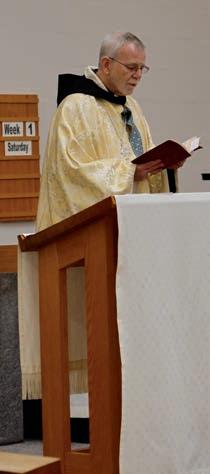
Photo: S. Karen (right) and Abbot John wore beautiful copes embroidered by sisters of Saint Benedict’s Monastery. Photograph taken by Sister Laura Suhr.
Monks of Saint John’s Abbey Elect New Abbot
The monks of Saint John’s Abbey elected Abbot Douglas Mullin as their new abbot on January 9, 2024. He succeeds Abbot John Klassen, who served for the previous 23 years. We hold their community in steadfast prayer during this time of transition. Congratulations!
Photo: Abbot Douglas presiding over Eucharist at Saint Scholastica Convent
In 2023, we celebrated the 75th anniversaries of two daughter monasteries founded by Saint Benedict’s Monastery: Monasterio Santa Escolastica (Saint Scholastica Monastery) in Humacao, Puerto Rico, and St. Paul’s Monastery in St. Paul, Minn.
The Benedictine Sisters in Puerto Rico also celebrated the 60th anniversary of their high school, Colegio San Benito. Sister Lois Wedl, former principal, as well as Sisters Susan Rudolph and Marlene Schwinghammer, were present for this celebration.

Left to right: Sisters Lois Wedl, Susan Rudolph and Marlene Schwinghammer in Puerto Rico


The Office of Mission Advancement
104 Chapel Lane, St. Joseph, MN 56374-0220
(320) 363-7110 • www.sbm.osb.org






Address Service Requested
Please help us keep our mailing list current.
New address
Please remove my name
Receiving more than one copy (send all labels, indicating the correct one).
Non-Profit Org.
U.S. Postage PAID
St. Cloud, MN Permit No. 2650
Studium, a program of Saint Benedict’s Monastery, combines three key elements of Benedictine life: the love of learning, the desire for God, and the commitment to beauty. Placing special emphasis on the love of learning and honoring scholarship as a sacred ministry, Studium provides the hospitality and environment where members motivate, support and empower one another in their creative endeavors, sharing in the transforming work of the Spirit.
Are you in need of:
» help starting, getting unstuck, or finishing?
» time away from daily distractions?
» a nurturing, supporting community of passionate people which is there when you need them, but out of the way when you need to concentrate?

Are you at the point in your project where:
» it’s ready, but you’re unsure how to begin?
» it’s underway, but you’re stuck?
» it’s almost done, but you need a final push?
Whether you’re at the beginning, in the middle, or approaching the end of your project, and whether it’s a slog or a snap, Studium may be just what you need—for a stay of anywhere from a week to four months.
For more information, visit www.sbm.osb.org/ministry/spirituality-center-studium/#studium or contact Sister Ann Marie Biermaier, director of Studium, at (320) 363-7172 or abiermaier@csbsju.edu.